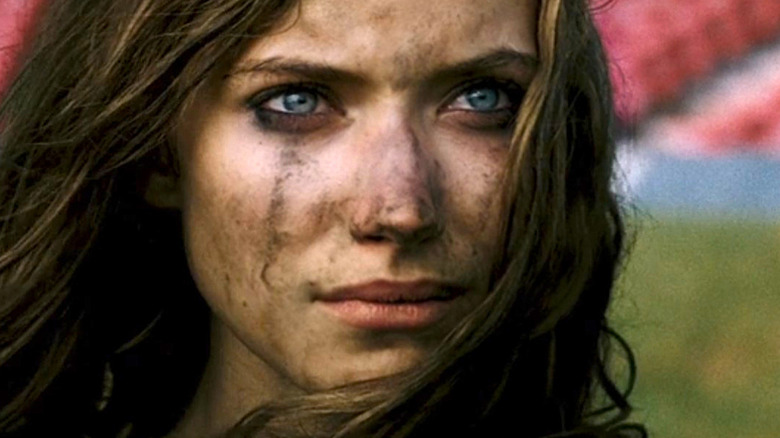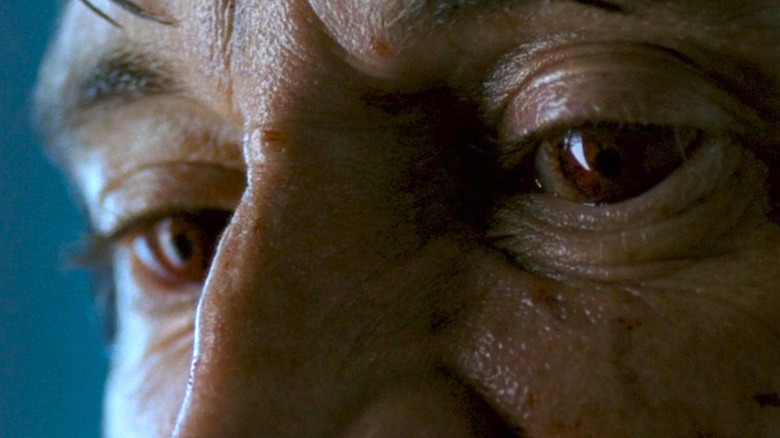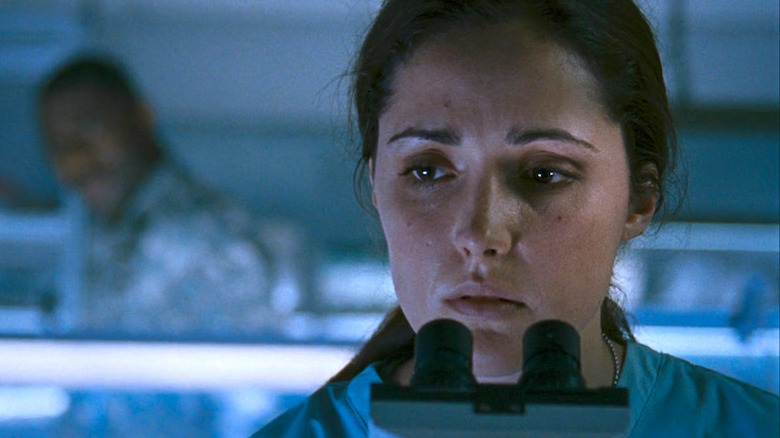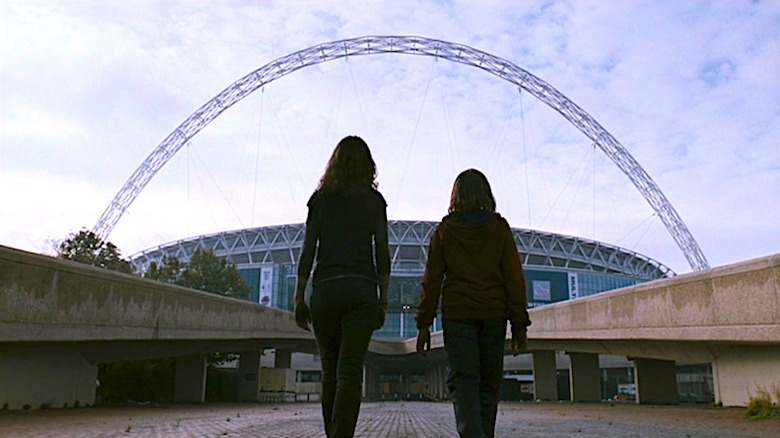The Ending Of 28 Weeks Later Explained
When "28 Days Later" first arrived in theaters back in 2002, audiences were stunned by its shocking new approach to typical zombie horror. It swaps the slow, moaning undead for the sprinting, screaming "infected," who rip and tear their way through their victims thanks to the Rage Virus, which escapes when animal activists free chimpanzees out of a laboratory. Director Danny Boyle worked with critically acclaimed scribe Alex Garland on the first film, and they both returned as producers for the 2007 sequel, "28 Weeks Later." The second film follows what happens when the U.S. Army brings British refugees back to London after all the infected have died due to starvation — and unfortunately, the Rage virus also comes back with a vengeance.
The arrival of this sequel was something of a surprise, since "28 Days Later" ends on a hopeful note with Jim (Cillian Murphy), Selena (Naomie Harris), and Hannah (Megan Burns) all waiting for help from international authorities as the infected die out. However, none of the original cast return for the sequel — so their fates are left up in the air. Instead, the sequel focuses on the revival of the Rage Virus itself, which occurs when siblings Tammy (Imogen Poots) and Andy (Mackintosh Muggleton) return to London to live in the quarantine zone with their father Don (Robert Carlyle).
Unfortunately, it's only a matter of time before hordes of infected are running riot through the streets of London again. Although the quarantine zone is managed by the U.S. army, they're not equipped to deal with a full blown outbreak. But why does the virus return in the first place? Does anyone survive this time? What does it mean for the rest of the world? Here's the ending of "28 Weeks Later," explained.
A new outbreak
So how does the Rage virus rear its ugly head again, anyway? Well, it's all down to those pesky kids: Tammy and Andy. They break out of the quarantine zone to find their old house to see if they can retrieve any of their belongings — and maybe grab a few treasured photos so they can remember their mother, Alice (Catherine McCormack). This is largely because Don tells his children that Alice died while they were hiding from the infected. What he doesn't tell them that he left her behind. He's going to regret that. But to the siblings' surprise, they actually find Alice living in the attic of their house. Plot twist!
Alice survived the attack from the infected because of a genetic immunity to the virus — although she's now a carrier, meaning she can pass it on to other people. Oh dear. Once Scarlet (Rose Byrne) establishes this at the U.S. army's base of operations, it's pretty clear where things are headed. Unfortunately, Don sneaks his way in to see Alice, who's strapped to a gurney so she can't accidentally infect anyone. It's a touching reunion between the two, but as Don's guilt gets the better of him, he catches the virus when he kisses his wife.
This is essentially a way of making Don pay for the sin of leaving Alice behind (which, recall, occurs during his selfish escape from the farm in the harrowing opening scene of the film). After Don is infected, he savagely murders his wife by shoving his thumbs into her eyes, and he then quickly infects a number of personnel on the base, at which point all hell breaks loose. Basically, Tammy and Andy's dad is to blame for all the death and destruction that ensues.
The last hope
Obviously, the infected quickly overwhelm the quarantine zone — causing plenty of bloody carnage along the way. But all isn't lost, as Scarlet realizes that Andy has the same genetic immunity to Rage, which makes him the best possible chance of finding a cure to the infection. So it's up to Scarlet and sniper Doyle (Jeremy Renner) to get Tammy and Andy to safety, which isn't easy when there are hordes of infected roaming the streets. To make matters worse, the army initiates a firebombing strike, as well as a shoot-to-kill order on all the survivors.
As cruel as it is, it's an understandable move from General Stone (Idris Elba) because they can't afford to let the virus escape the country. But it's no less heartbreaking when Doyle gets burnt alive by soldiers when he's helping Scarlet jumpstart a car. The sniper's sacrifice is ultimately what gets the trio away from the attacks, as they escape into the subway. But they come face-to-face with Don, who's still infected, and beats Scarlet to death, leaving the siblings to fend for themselves.
This is where "28 Weeks Later" really hammers home that Andy is immune to the virus like his mother, since Don attacks his son and bites him. Ultimately the film is a test to see how strong the bond is between the two siblings — they managed overseas together while Britain was on lockdown, they journeyed out of the quarantine zone for closure about their mother's supposed death, and they survive their infected father by relying on one another.
Tammy protects her brother by killing her father, while Andy briefly runs away to save his sister when thinks he's going to turn into an infected. Basically, as long as they have each other, they'll be okay.
Escaping London
Thankfully, Tammy and Andy find their way to Wembley Stadium where Doyle's pilot friend, Flynn (Harold Perrineau), is waiting in his helicopter. Although Scarlet and Doyle died on the way, Flynn still chooses to take the siblings out of the country knowing that Andy could actually be the answer to stopping the infection. Plus, having Andy in his care means Flynn is more able to get to a secure location, which would make it easier to get back to his wife and child — so that's why he flies them over the English Channel towards France.
Unfortunately, their fate is left unknown, as one of the final moments of the movie shows the empty helicopter 28 days later (nice) with a French voice coming through the radio. Considering Tammy and Andy's resilience got them this far, it seems likely that they've survived and they'll find a way of creating a cure. But the Rage Virus has reached France, as the last scene sees the infected running up towards the Eiffel Tower. Oh dear.
So what's next? Well, writer Alex Garland recently told Yahoo! Entertainment that he knows what would happen in a follow-up, but it'd be a vastly different movie. "I have got a really cool idea for it, but it's a much bigger movie, and one of the things about '28 Days Later' is that it was small and punk and this idea is less small and punk. But me and Danny speak about it. Every couple of years it will come up, or going, 'Do you want to do that?' and then for some reason it never happens."
Maybe one day (perhaps, say, 28 years after the end of this film?) the Rage Virus will rear its head for a third and final time.



